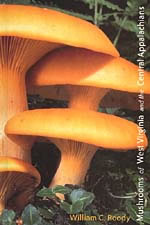

For those of us who live and hunt mushrooms in the Appalachian region of the southeastern U.S., this book came as a welcome addition to our arsenals of mushrooms identification books. It is very well laid-out, with the picture and description of each mushroom on the same page. There is a brief generalized key in the beginning, and the mushrooms are grouped by sections based on their characteristics, such as; fruit body growing on wood vs. the soil, stalk lateral or lacking, gills descending down the stalk (decurrent) vs. gills free from the stalk (non-decurrent), and so on. The descriptions of the mushrooms are very clear and concise. Common names, when known, are given with the Latin names, as well as clear, easy to understand descriptions of the fruit body’s characteristics. Spore print colors and spore sizes are mentioned, as well as the types of substrates where the specimens are typically found. The photographs are excellent, taken in natural settings, with differing angles to show not only the caps and stems, but the undersurface as well.
Bill Roody is a biologist for the WV Division of Natural Resources Wildlife Diversity Program and he is certainly a knowledgeable mycologist. His writing style is clear and concise, and he typically adds very helpful, well-written comments that are sometimes lengthy, but never rambling. Like most books, he indicates whether a mushroom is edible, poisonous, or unknown, and often warns of possible look-alikes. But, he often takes this a step further to tell why look-alikes are often confused. For example, his comments on the Jack O’Lantern, Omphalotus illudens, a very common poisonous mushroom found in our region that is sometimes mistaken for the edible and prized Chanterelle, begins like this:
The Jack O’Lantern is surely one of the most spectacular of all mushrooms. It sometimes occurs in enormous clusters that can be seen from a distance, or even spotted from a moving vehicle. The cluster sometimes grows in lawns and grassy places from the remaining root systems of trees that are no longer present, leading to confusion with edible Chanterelles, Cantharellus cibarius, which are not associated with decaying wood. The Jack O’Lantern can further be distinguished from Chanterelles by having sharp-edged true gills rather than gill-like folds or ridges beneath the cap…
So, you can see by above entry, this book is much more than just an identification book, it is full of well-conveyed, valuable information, and the entire book is very thoughtfully laid out. Mushrooms of West Virginia and the Southern Appalachians would be a good first choice mushroom ID book for those in the Appalachian region, and is a must inclusion to the library of any serious mushroom hunter. There is one word of caution, however. The paperback version of this book is bound very poorly, and with age, the pages tend to start falling out. I learned this from personal experience, and have since purchased the hard-cover copy. So far it is holding up really well. So, do yourself a favor; go ahead and purchase the hardbound copy of this book-in the long run, you’ll be glad you did!
Review written April 3, 2010 / Steve Roberts / CMS President
****************************************************************
simply close this document to return to the Cumberland Mycological Society web site
to return to previous menu